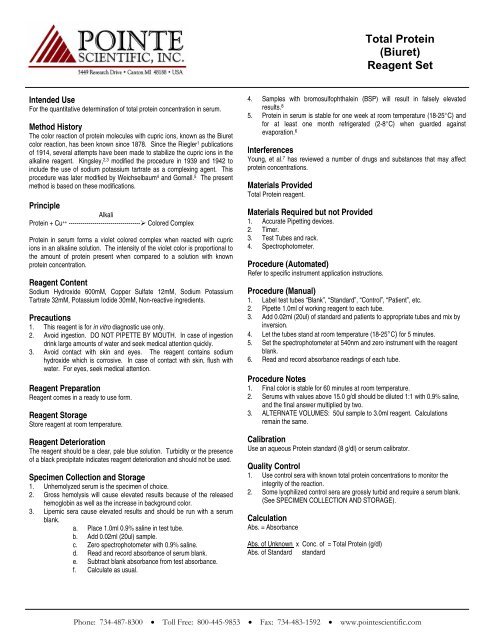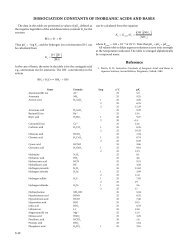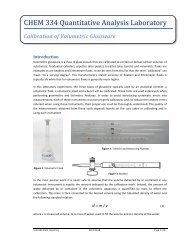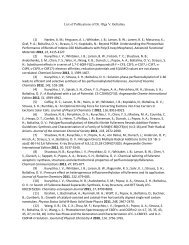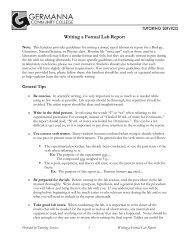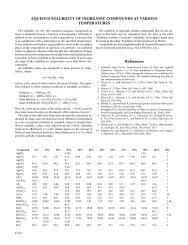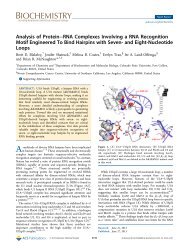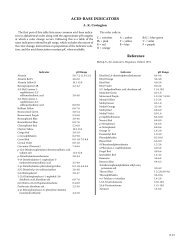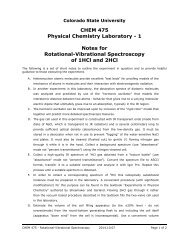Total Protein (Biuret) Reagent Set - BrandSD
Total Protein (Biuret) Reagent Set - BrandSD
Total Protein (Biuret) Reagent Set - BrandSD
- No tags were found...
You also want an ePaper? Increase the reach of your titles
YUMPU automatically turns print PDFs into web optimized ePapers that Google loves.
<strong>Total</strong> <strong>Protein</strong>(<strong>Biuret</strong>)<strong>Reagent</strong> <strong>Set</strong>Intended UseFor the quantitative determination of total protein concentration in serum.Method HistoryThe color reaction of protein molecules with cupric ions, known as the <strong>Biuret</strong>color reaction, has been known since 1878. Since the Riegler 1 publicationsof 1914, several attempts have been made to stabilize the cupric ions in thealkaline reagent. Kingsley, 2,3 modified the procedure in 1939 and 1942 toinclude the use of sodium potassium tartrate as a complexing agent. Thisprocedure was later modified by Weichselbaum 4 and Gornall. 5 The presentmethod is based on these modifications.PrincipleAlkali<strong>Protein</strong> + Cu ++ ------------------------------------‣ Colored Complex<strong>Protein</strong> in serum forms a violet colored complex when reacted with cupricions in an alkaline solution. The intensity of the violet color is proportional tothe amount of protein present when compared to a solution with knownprotein concentration.<strong>Reagent</strong> ContentSodium Hydroxide 600mM, Copper Sulfate 12mM, Sodium PotassiumTartrate 32mM, Potassium Iodide 30mM, Non-reactive ingredients.Precautions1. This reagent is for in vitro diagnostic use only.2. Avoid ingestion. DO NOT PIPETTE BY MOUTH. In case of ingestiondrink large amounts of water and seek medical attention quickly.3. Avoid contact with skin and eyes. The reagent contains sodiumhydroxide which is corrosive. In case of contact with skin, flush withwater. For eyes, seek medical attention.<strong>Reagent</strong> Preparation<strong>Reagent</strong> comes in a ready to use form.<strong>Reagent</strong> StorageStore reagent at room temperature.<strong>Reagent</strong> DeteriorationThe reagent should be a clear, pale blue solution. Turbidity or the presenceof a black precipitate indicates reagent deterioration and should not be used.Specimen Collection and Storage1. Unhemolyzed serum is the specimen of choice.2. Gross hemolysis will cause elevated results because of the releasedhemoglobin as well as the increase in background color.3. Lipemic sera cause elevated results and should be run with a serumblank.a. Place 1.0ml 0.9% saline in test tube.b. Add 0.02ml (20ul) sample.c. Zero spectrophotometer with 0.9% saline.d. Read and record absorbance of serum blank.e. Subtract blank absorbance from test absorbance.f. Calculate as usual.4. Samples with bromosulfophthalein (BSP) will result in falsely elevatedresults. 85. <strong>Protein</strong> in serum is stable for one week at room temperature (18-25°C) andfor at least one month refrigerated (2-8°C) when guarded againstevaporation. 6InterferencesYoung, et al. 7 has reviewed a number of drugs and substances that may affectprotein concentrations.Materials Provided<strong>Total</strong> <strong>Protein</strong> reagent.Materials Required but not Provided1. Accurate Pipetting devices.2. Timer.3. Test Tubes and rack.4. Spectrophotometer.Procedure (Automated)Refer to specific instrument application instructions.Procedure (Manual)1. Label test tubes “Blank”, “Standard”, “Control”, “Patient”, etc.2. Pipette 1.0ml of working reagent to each tube.3. Add 0.02ml (20ul) of standard and patients to appropriate tubes and mix byinversion.4. Let the tubes stand at room temperature (18-25°C) for 5 minutes.5. <strong>Set</strong> the spectrophotometer at 540nm and zero instrument with the reagentblank.6. Read and record absorbance readings of each tube.Procedure Notes1. Final color is stable for 60 minutes at room temperature.2. Serums with values above 15.0 g/dl should be diluted 1:1 with 0.9% saline,and the final answer multiplied by two.3. ALTERNATE VOLUMES: 50ul sample to 3.0ml reagent. Calculationsremain the same.CalibrationUse an aqueous <strong>Protein</strong> standard (8 g/dl) or serum calibrator.Quality Control1. Use control sera with known total protein concentrations to monitor theintegrity of the reaction.2. Some lyophilized control sera are grossly turbid and require a serum blank.(See SPECIMEN COLLECTION AND STORAGE).CalculationAbs. = AbsorbanceAbs. of Unknown x Conc. of = <strong>Total</strong> <strong>Protein</strong> (g/dl)Abs. of Standard standardPhone: 734-487-8300 • Toll Free: 800-445-9853 • Fax: 734-483-1592 • www.pointescientific.com
<strong>Total</strong> <strong>Protein</strong>(<strong>Biuret</strong>)<strong>Reagent</strong> <strong>Set</strong>Example: Abs. of Unknown = 0.350, Abs. of Standard = 0.400Concentration of Standard = 8 g/dlThen: 0.350 x 8 = 7.00 g/dl0.400Limitations1. Samples with values above 15.0 g/dl should be diluted 1:1 with 0.9%saline, re-run and result multiplied by two.2. The <strong>Biuret</strong> procedure is not sensitive at low ranges (


